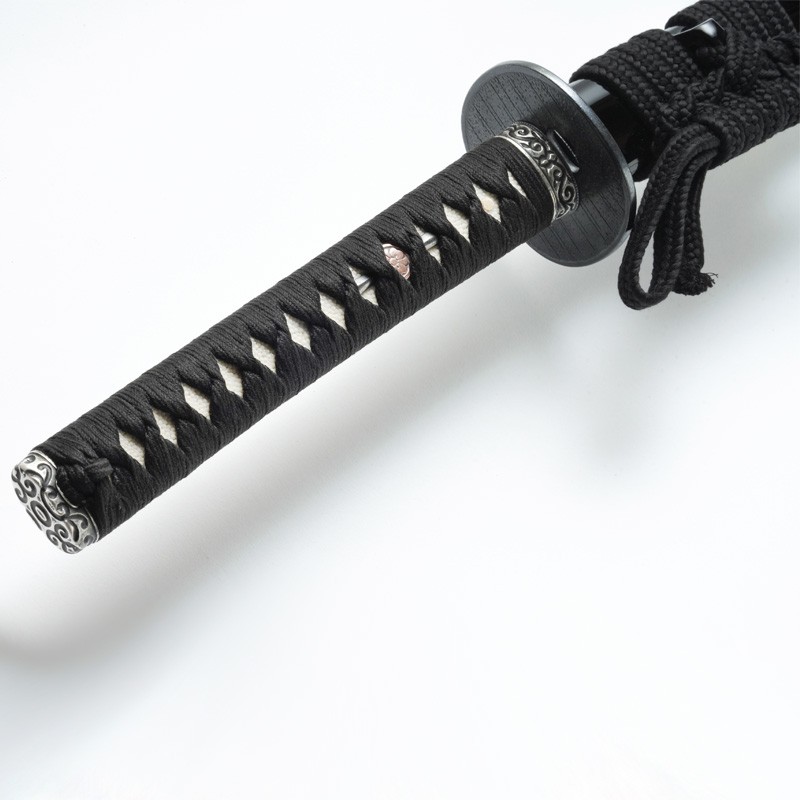
































Original model only
More informations about this product
The Hon Koshirae 本拵 is a customizable Iaito with a semi-heavy blade and superior finish quality.
Inspired by the 'Kanbun' period blades, this Hon Koshirae takes the thickness of the productions of that time. The semi-bladeheavy for experienced and experienced practitioners. It is the closest model to the balance and weight of a real Katana.
During the Kanbun era (1661-1673), and since the beginning of the Edo 'peace' era (from 1600), the manufacture of Japanese swords focuses on aesthetics. Many great blacksmiths produced during the era of swords 'Kanbun Shinto' (1658-1683), one can thus quote Inoue Shinkai, Kotetsu, Sukehiro, Yasutsugu, Kanenori, Kinmichi, Yoshimichi, Kanesada, Kunisuke...
The sugata (shapes) of the blades of this period are typical, little curvature, a short kissaki, a thick kasane, a Saki Haba very reduced compared to the Moto Haba, and often higher dips at the Monouchi. These characteristics made these blades more impact resistant.
The peculiarities of the shapes of the blades of the Kanbun period would be due in particular to a change of handling of the sword. A blade with a pronounced curvature, like the Koto blades, makes the cuts easier, but makes the stomachs much more difficult. The practice in closed, even confined places reduced the distance between the swordsmen, and thus favored the development of spikes and stomachs. The blades had to be less curved, shorter and stronger.
All customization options are possible on this Iaito, we advise you to keep specifically the Fuchi and Kashira which is, with the thickness of the blade, the specificity of the Hon Koshirae.
The blade type for this fixture is a semi-heavy blade, approximately 970g.
Nagasa length possible from 2.20尺 (66.6cm) to 2.70尺 (81.8cm).
size charts (see attached table of recommended sizes)
Standard (Basic) Mounting Specifications:
Hamon: Suguha (straight)
Habaki: Shonai (old-fashioned design), made of brass.
Tsuba: Shigure Ishime 時雨石目 (Light Grainy Relief Rain Pattern), Naga Maru Gata (Oval) Iron.
Fuchi/ Kashira: Kuri Bori No Zu 倶利彫の図 (Arabesque-shaped engraving pattern), in silver copper with an old-fashioned patina engraving base.
Same: Galuchat (Roussette or Raie), White.
Menuki: Kenkatabami 剣片喰, with a golden pattern of three heart shapes separated by three blades, with two double-edged blades (Tsurugi) on each side. The hearts are leaves of Oxalis Corniculata, symbol of strong vitality.
Tsukaito: Hineri Maki Cotton Handle Braiding.
Sageo: Thick black cotton.
Saya : Kuroro 黒呂塗り, Saya glossy black lacquered, Magnolia wood, with golden Shitodome, flat Kojiri.
The Minosaka Workshops :
The Iaito we offer come from Minosaka workshops in Gifu, Japan, and are manufactured in their workshop in Japan.
Gifu is one of the top places known for the forging of traditional sabres, including the Mino tradition, dating from the 14th century. Minosaka workshops are Iaito’s leading producers of tradition.
This traditional workshop manufactures its chrome-plated Zamak Iaito (Zinc and Aluminum alloy with some Copper) which is stainless.
This non-ferrous alloy makes the Iaito blunt and unsharpenable:
They are practical tools for Kata, without contact between the blades.
Share your opinion
error Your review appreciation cannot be sent
feedback Report comment
check_circle Report sent
error Your report cannot be sent